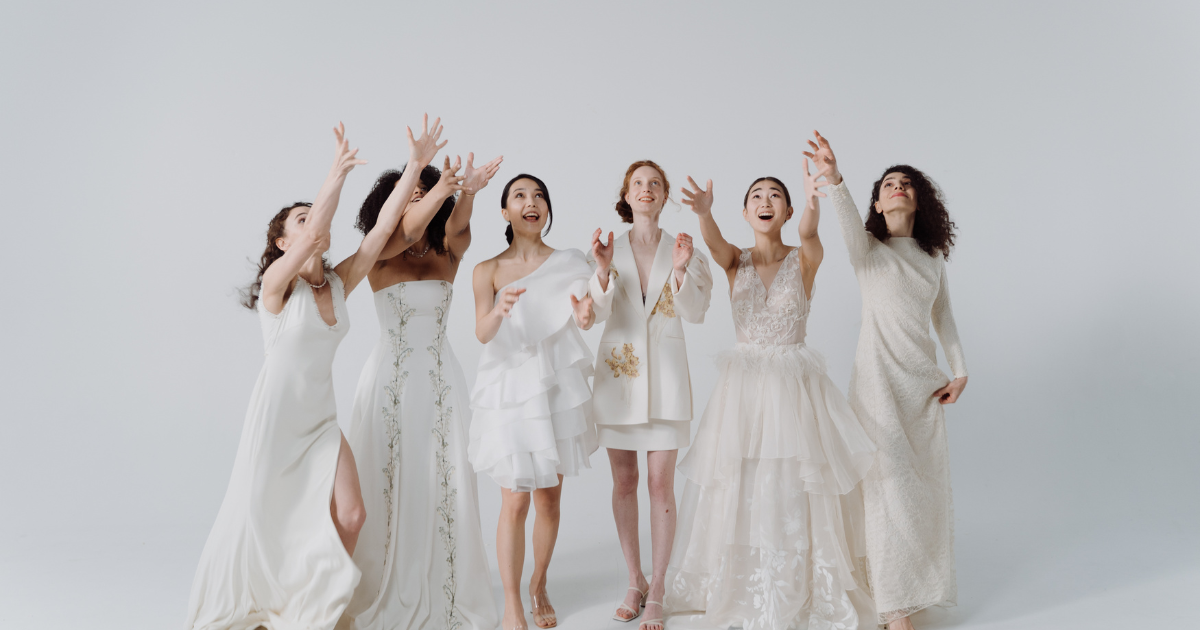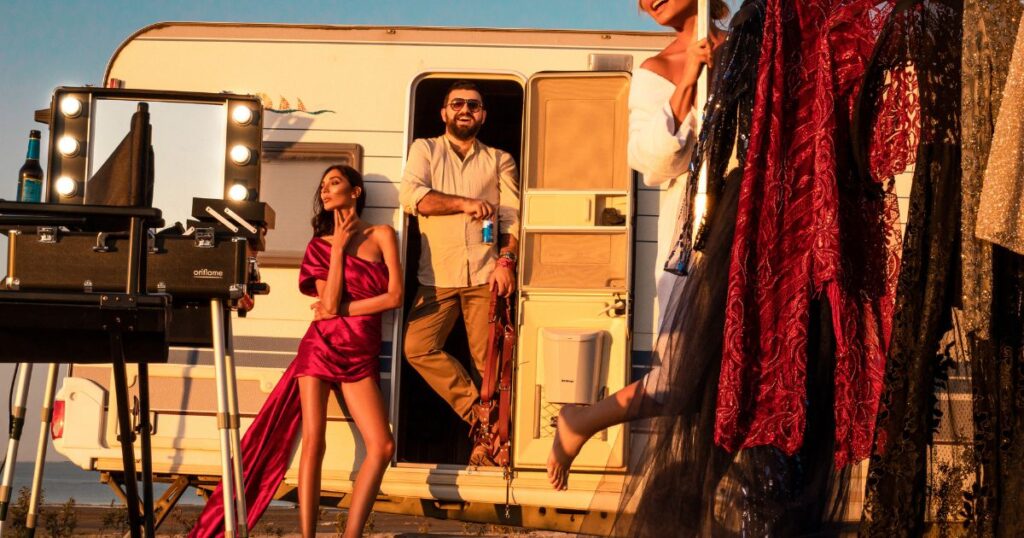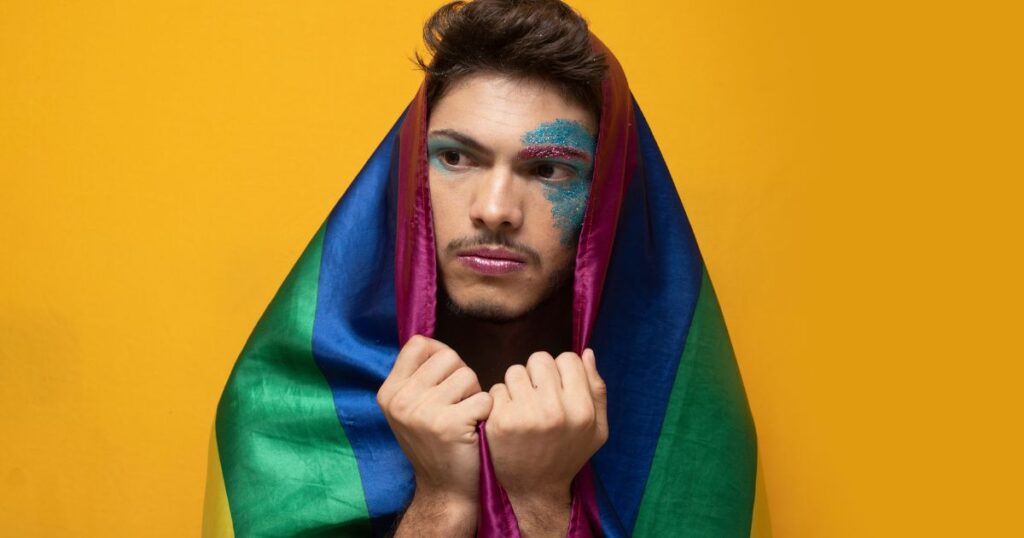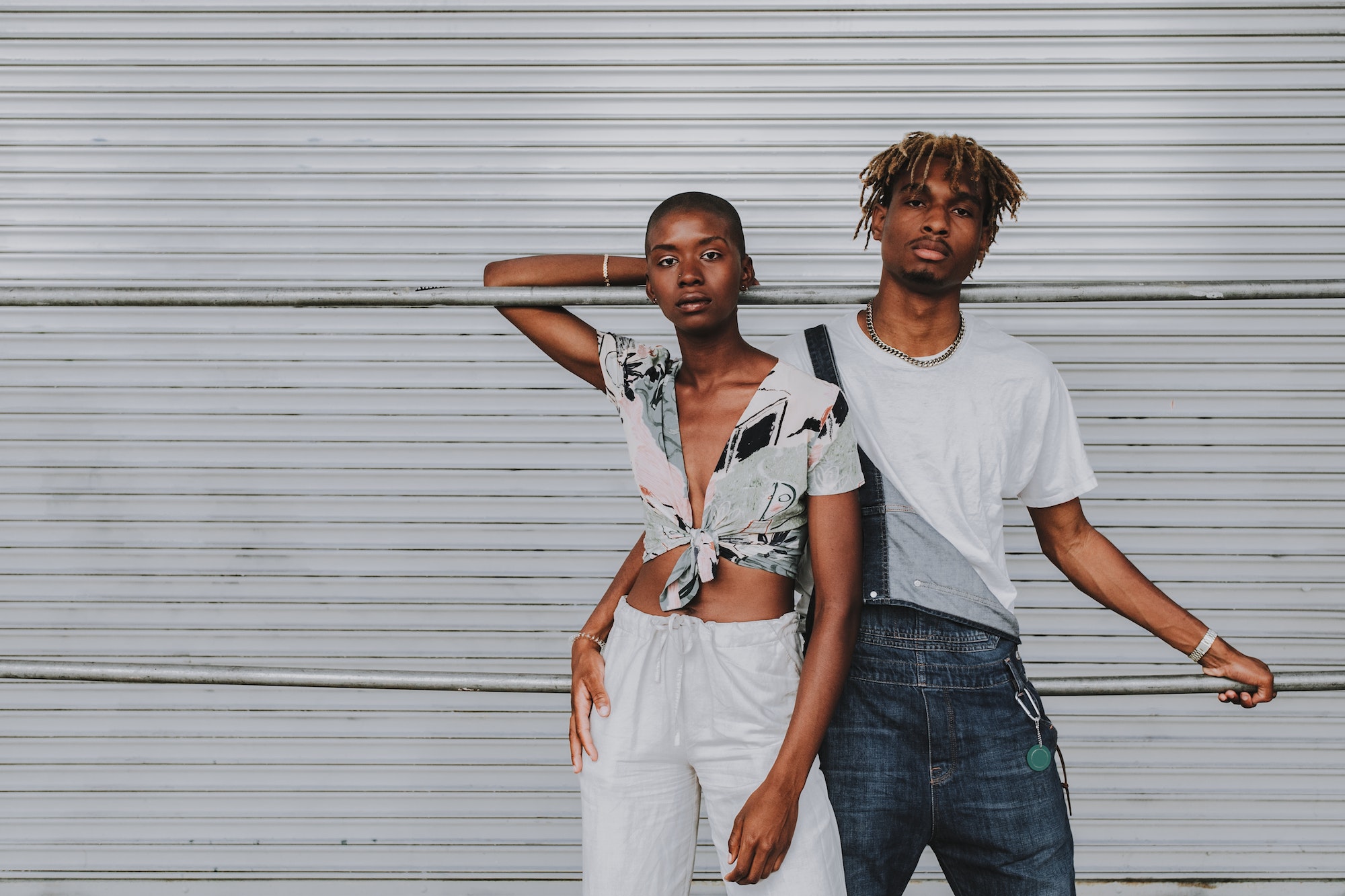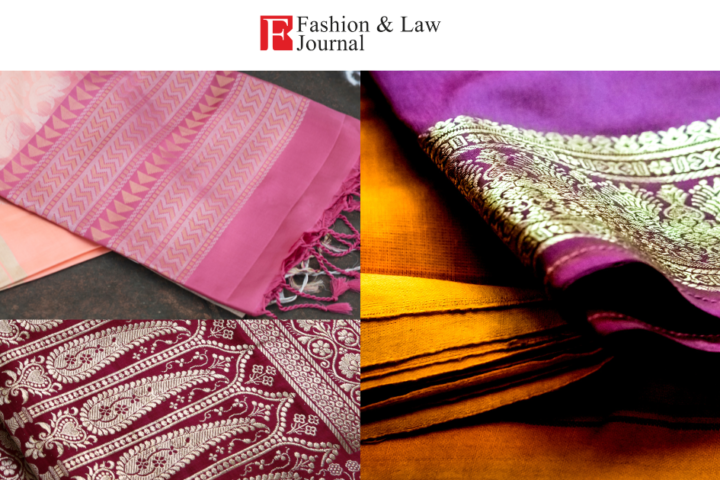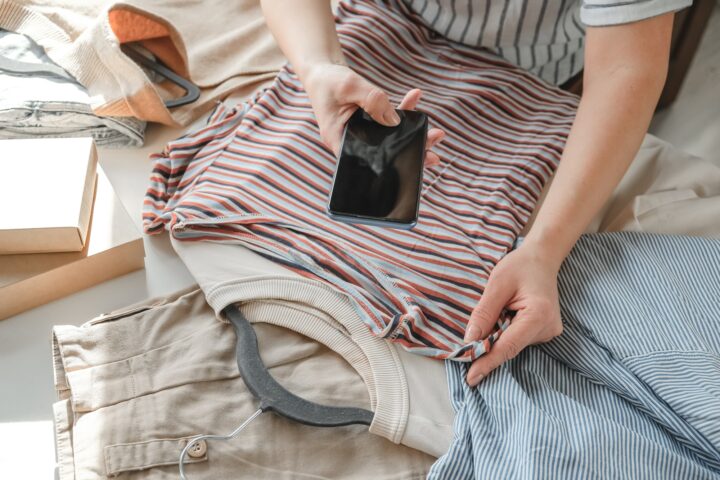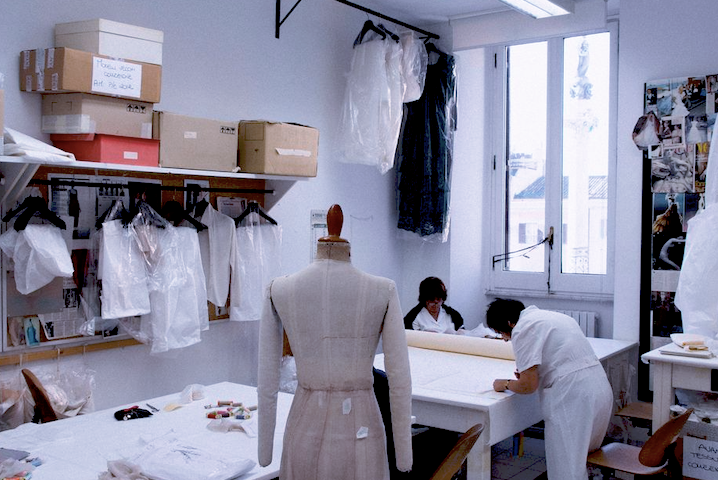If you think that brides have always walked down the aisle in their dream gown, let alone a white one, it’s time to learn the truth about the history of wedding dresses. Let us deep dive and explore the fascinating evolution of wedding dresses and uncover the real deal!
Weddings, the timeless ceremony celebrating love and togetherness, have an extensive and intricate history dating back centuries. However, what truly captivates every attendee’s memory is the bride’s exquisite wedding dress.
Be it a fashion faux pas or the most beautiful ensemble, the wedding dress remains an unforgettable hallmark that resonates with the couple and guests alike for years to come.
Just like any other trend, wedding and wedding dresses have undergone a significant evolution, reflecting the ever-changing fashion world. Gone are the days of frilly, high-necked corseted gowns, replaced by the jaw-dropping silhouettes, and stunning embellishments, sleek and simple to glamorous and glitzy.
Gone are the days of frilly, high-necked corseted gowns, replaced by the jaw-dropping silhouettes, and stunning embellishments, sleek and simple to glamorous and glitzy.
Just like any other clothing item, wedding dresses have adapted with the times, mirroring the latest trends in contemporary fashion catering to the fierce and fabulous 21st gen aesthetic today.
Origins of the wedding dress
Historians say that the idea of wearing a unique garment for weddings goes way back, with Chinese folklore being the earliest known origin. Legend has it that a princess wore a phoenix dress and crown, which brought her good luck and strength in marriage. Even today, Chinese brides prefer a striking red gown with a phoenix tail as a symbol of good fortune.
Silk wedding robes in Korea and Japan were used in different styles based on the dynasty and season, but they were always full of bright colours, perfect for royalty.
While the concept of marriage dates to ancient civilizations such as Sumer, Babylon, and Assyria, the idea of weddings being a romantic affair is more recent. Historical analysis of paintings featuring Assyrian artifacts, including Edwin Long’s 1875 interpretation, suggests that women would dress in draped white or cream garments to be auctioned off in a market-like setting, with the less desirable women assigned to “commoners.”
In ancient Rome, brides rocked braided hairstyles and veils in shades of deep yellow, while Athenian women wore violet and red dresses held by a symbolic girdle that the groom would loosen after tying the knot.
Wedding dresses in 19th century Britain
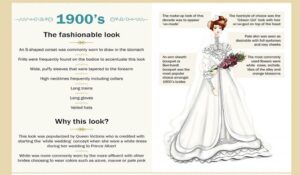
There’s a popular theory that the tradition of wearing a white wedding dress comes from the ancient marriage-market custom, but it’s just as possible that it gained popularity during the Victorian era, where it was associated with purity and virginity. White dresses were a status symbol at expensive British weddings in the 1400s and 1500s, but it wasn’t until Queen Victoria’s wedding in 1840 that white gowns became the norm in the western world. Though costly and hard to maintain, white dresses became the go-to for brides looking to make a statement on their big day.
Fun fact: Wedding dresses didn’t always have to be white. It wasn’t until 1840 when Queen Victoria married Prince Albert that white became the go-to colour, symbolizing purity (although the rich had already been wearing white before then).
Queen Victoria’s wedding dress set the standard for modern bridal fashion. Her gown featured a cinched waist, a voluminous skirt, and layers of ivory lace, and this style became the norm for wedding dresses. Bridesmaids also followed suit and it was common for the bride and her squad to wear similar dresses, possibly inspired by ancient Roman folklore that believed wearing similar clothes would confuse evil spirits.
As we moved into the Edwardian era, wedding dresses got a bit more stress-free. The ladies were all about those loose, delicate gowns made from dreamy fabrics. High necks, ruffles and long sleeves were still in, but they also started rocking some seriously fancy headpieces and bouquets. It was all about feeling confident and comfortable, no longer feeling the pressure to fit into one rigid ideal of the “perfect” bride.
Queen Victoria’s white wedding dress in 1840 is often credited with popularizing the white wedding gown, which has since become a staple of Western wedding fashion.
1920s
Wedding dresses today take cues from past styles but have evolved quite a bit. A century ago, in the 1920s, wedding dresses were all about royalty vibes. With women’s right to vote, gowns shifted from heavy ballgowns to lighter, straight lace and silk dresses. Iconic designer Coco Chanel even shook things up with a daring new style: a short wedding dress with a long tulle train. When it comes to collecting vintage bridal haute couture, there’s one iconic brand that reigns supreme: Chanel.
Brides in the 1930s kept it simple.
The tough times of the Great Depression and the looming shadow of World War II definitely had an impact on wedding dress styles. Dresses became more understated, with closer-fitting silhouettes, longer hemlines, and flowing trains. Brides cared about making the most out of their wedding ensembles. They would pick dresses that could be dyed and worn later on. If buying a new dress wasn’t an option, they would simply wear their nicest one. Unlike today, it was harder for women to imitate the fashion of movie stars. While they may have been more affordable, they still had that royal elegance and classic white hue that we all know and love in a traditional wedding dress.
Since money was tight, most women wore their fanciest dress they already owned to their weddings.
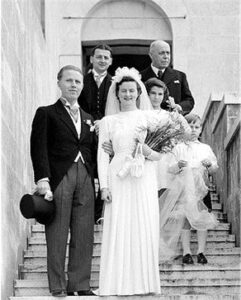 Simple wedding dress amidst war time
Simple wedding dress amidst war time
Wedding dresses in the 1940s and 1960s
In the 1940s, women’s fashion was split into two eras – wartime and post-war. During the war, rationing led to simple designs and reusing dresses, but after the war, the New Look by Christian Dior emerged and brought with it a stylish and feminine approach, which was perfect for the boom in weddings after the troops returned home.
In the early 1940s, wedding fashion was limited by the war, as rationing affected both food and clothing. Brides of modest means had to settle for practical dresses due to the scarcity of resources. It was a tough time, but creativity and resourcefulness were still on display. Women wore their best clothes or altered versions of their husband’s suits, in line with the “make do and mend” mindset of the time.
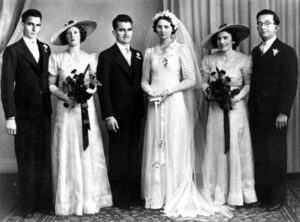
Photo by Pinterest: 1940’s Bridal Fashion amidst world war
Queen Elizabeth got married to Prince Phillip in 1947, after the war was over, but the country was still dealing with rationing and a gloomy mood. To avoid looking too extravagant, Elizabeth opted for an ivory silk and pearl dress that was simple compared to the dresses worn by previous royals. Her dress became an inspiration for romantic brides who wanted to look youthful and feminine, featuring delicate touches like embroidered flowers or a shorter skirt.
In 1947, Christian Dior debuted his line of clothing called “Corolle”, which became known as the New Look, and it brought a fresh change to women’s fashion. The collection emphasized the female form with tighter waists and fuller skirts, taking advantage of the increased availability of fabrics post-WWII. This style of fashion remained popular throughout the late 1940s and 1950s, and it influenced the design of many wedding dresses during that time.
The silhouette of the 1950s was revolutionized by French designer Christian Dior’s “New Look” which included his signature hourglass suit featuring full skirts with pleats, cinched waists, padded hips, and relaxed shoulders.
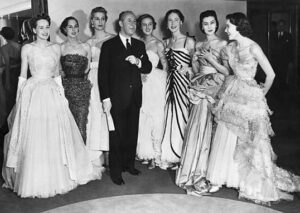
Getty Images: Christian Dior 1950s “New Look”
While in 1950s ball gowns were everywhere.
Long ball gowns made a comeback, and designers began using pearl and crystal appliques to add some sparkle. Some brides even ditched the classic white dress for more colourful options in pretty pastel hues. It was all about making a statement and standing out.
Wedding dresses in the 1950s were all about big, poofy skirts, perfect for twirling around on the dance floor. The strapless trend became popular as a rebellion against the more conservative, covered-up styles of the past.
But not all brides were ready to go sleeveless just yet. “It started off slowly,” explains the fashion historian Urshel, “Because it was still seen as a little bit risqué.”
In the 1950s and 60s, wedding dress fashion took on a more playful and flirtier vibe. Full skirts were still in style but they were shorter in length. Some brides were all about that traditional look, going for long and full dresses but keeping it fresh and young by going off the shoulder or strapless.
By the 1960s, modern styling was in vogue with brides opting for everything from long trains and sleeves to short mini dresses.
The 1960s marked a shift away from traditional white wedding dresses, with brides embracing bright colours like canary yellow and playful designs such as coat dresses and practical getaway outfits made from cotton. Dresses with floral and metallic details were all the rage, while veils tended to be short. Brides ditched the bulky ball gowns of the ’50s and opted for slimmer “column” dresses, with some choosing dresses that were a mix between a ball gown and a column dress.
(Toni Frisell/John F. Kennedy Presidential Library and Museum)
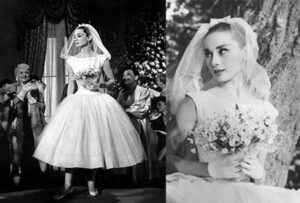
Photo: Elegancepedia.com – Audrey Hepburn wedding dress 1954 designed by Pierre Balmain
Wedding dresses from 1970s-1980s
The 1970s had two totally different vibes going on: one was all about the flowy and bohemian look, while the other was more about clean and corporate styles. Celebs were rocking two-piece suits, while royal fam and musician muses were all about those long, graceful dresses with puffy sleeves and cool headgear.
Then, the 80s came in and wedding dresses were all about big ball gowns in white and cream shades. Princess Diana was a total trendsetter with her ivory silk wedding dress that had poufy shoulders, a lace V-neck, and a 26-foot train. It is arguably the most iconic gown worn by a royal bride. The 80s were all about the Bohemian vibe, featuring square necklines, batwing sleeves, and empire waists. Even though women had been moving away from traditional hoop skirted silhouettes, Lady Di brought it all back with her huge taffeta dress when she got married in 1981. With 750 million people watching, she totally owned the “more is more” look of the 80s with oversized bows, lace, and puff sleeves. It was totally a fashion moment!
Wedding dresses in the 1990s – 2000s
Back in the ’90s, women were wearing all kinds of wedding dresses, but they were usually all about that white colour scheme. Some brides went for a modern approach with tight gowns, while others kept it classic with off-the-shoulder bodices, sweetheart necklines, and ball gown skirts. While the hair was big but dresses were more minimalist and simpler.
Then, when the 2000s hit, strapless dresses were the new hotness. They still had that traditional mood with full skirts and long trains, but they also showed off a little skin with the collarbone and shoulders on display. But just like in the ’90s, some ladies went for more unusual styles, like tight dresses or short frocks. After so many years of back-and-forth, western wedding dresses were basically perfected and brides knew if they were more of a big-skirted or laid-back kinda gal.
In 1990, Vera Wang was slaying the game by opening her first bridal boutique and making strapless, figure-hugging dresses the ultimate wedding dress vibe. She paired these dresses with slicked-back up-dos and silver accessories, making brides everywhere drool.
While wedding dresses had been on fashion show runways since the ’50s, they really started to blow up in the ’90s, with big names like Calvin Klein, Versace, and Oscar De La Renta all showing off their signature occasion dresses.

Latest in Bridal Fashion
The latest trend in bridal fashion is all about combining vintage vibes with a modern twist. Wedding dresses now come in an endless array of styles and designs, with many brides opting for custom-made gowns to ensure a truly unique look. The focus is on creating something that is both timeless and on-trend, with nods to the past and a fresh, contemporary feel.
As society becomes more accepting and diverse, wedding dresses are also evolving to reflect individual style and expression. With more people embracing same-sex marriages, civil partnerships, and feminism, there is no longer a standard way to do bridalwear.
The focus is now on wearing what makes the individual feel special, whether it’s a caped-jumpsuit or a matching suit. Bridal blogging and online communities have emerged to help non-traditional brides find their perfect outfit, with sites like Rock N Roll Bride, Love My Dress, and Nu Bride showcasing that tradition can look different across cultures. The fashion industry is also following this trend, with high-street brands offering affordable wedding attire that caters to various body types and budgets.
ASOS has stepped up its game by offering a variety of Indian-inspired bridalwear to acknowledge that there are different wedding dress styles beyond the typical Western tradition. The COVID-19 pandemic may have also influenced the shift, as more couples opt for minimalistic outfits to match their scaled-down ceremonies.
“Bridal wear has become all about individual expression, with everything from caped-jumpsuits to matching suits being embraced as long as it makes the wearer feel like a star.”
Like any fashion item, there are still some styles that dominate the wedding dress scene. Last year, pop star Ariana Grande tied the knot in a Vera Wang dress and a bow-topped veil that would have been perfect for a glamorous 60s bride. Princess Beatrice also wore a vintage dress for her private 2020 wedding, passed down to her by the Queen and updated with chiffon sleeves from the 70s. No matter what era we’re in, bridalwear will always appreciate the charm of “something borrowed”—a custom as unique as the love it represents.
References:
- “The Evolution of the Wedding Dress,” Joel & Son, https://www.joelandsonfabrics.com/uk/the-memo/fashion-and-inspiration/the-evolution-of-the-wedding-dress
- Jess Edwards, “This is how much wedding dresses have changed since the 1900s,” Cosmopolitan (2015), https://www.cosmopolitan.com/uk/fashion/style/news/a37408/wedding-dresses-evolution-infographic/
- Jenessa Williams, “A history of wedding dresses,” Reader’s Digest (2021), https://www.readersdigest.co.uk/lifestyle/fashion-beauty/a-history-of-wedding-dresses
- Chloe Pantaziand Amanda Krause, “How wedding dresses have evolved over the last 100 years,” INSIDER (2020), https://www.insider.com/wedding-dress-every-decade-evolution-2017-4


